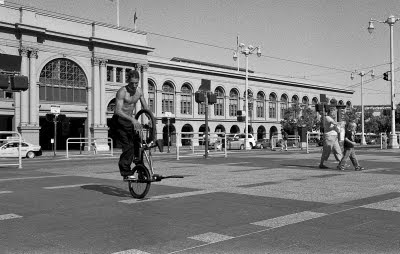Tri X 400

This shot was from a series I took as part of a class I am taking on B & W film. I have not used Tri X in many years and the new films are so much finer, but the assignment was to capture action with Tri X 400 film. I cheated and developed this in the darkroom 1 stop down. Given the light and the zoom I was using it was the only way to get a reasonable exposure.
This guy is a classic and works out every day in front of the ferry bldg. in downtown S. F.
Dan

7 Comments:
hi Dan, it is interesting to see your class assignments. Thanks for posting. Did you mean that you push processed at +1 stop (as if you shot at iso 800)? Do you remember what your exposure was? Did you use your new(used) Canon film slr?
--Warren
nice pic! you have really captured the "regular" out of the scene.. those people on the right are just walking away as if he was selling sunglasses...!
Warren, no I reduced the time in the tank to process as a ISO 200
Dan
Warren, this is the new (used) Canon and this was shot at f11 with a speed of 250. In order to pull the film down to 200 you keep it in the tank with developer for 8 minutes vs. the normal 10 minutes.
Dan
hi Dan, I'm trying to understand why you needed to pull the film to 200. Was it just for this shot? Wouldn't f11/500 have produced the same result without having to pull to 200? Just curious...
Thanks,
WT
Sorry Warren, I did not explain the assignment with one roll of film. We had to capture motion images and keep everything in focus background, subject and foreground, as well as, capture a subject and blur a moving background and/or foreground. Obviously the later would require slow shutter speeds, while shooting at f11 to f8 for reasonable DOF. With the high ISO you could not get proper exposure in daylight.
Now I recently was talking to the owner of Film Works in San Rafael, if you have not been there it is worth a trip across the bridge. They focus on film, but they also rent time on high end PCs for digital work, and will print large format. They have a great wealth of knowledge.
I was told that you can do two things instead of pulling the film. (a) you could use a polarizing filter and it will act like a 100 ISO Film or you can actually underexpose by three stops. I was told that B & W film has this much tolerance and you can adjust the image by dodging and burning in the Darkroom. This is only for B & W film. Color slide film has a tolerance of 1/3 of a stop and digital has a tolerance of 1/4 of a stop.
Your experience?
Thanx for taking the time on this subject.
Dan
A polarizer will give you an exposure adjustment, but it also alters the image in other ways and it may not be appropriate for your scene. It's best to use it for its intended purpose.
A better way to get the same result would be to use a ND (neutral density filter). They come in different densities so you would use the one is appropriate for you lighting situation.
Unless you are after a certain look or effect, I would not rely on push/pull processing, nor would I rely on a film's exposure latitude (and correct later). IMO, it's best to get the correct exposure using the appropriate filtering or lighting techniques at the time of exposure. Push/pull processing and intentional over/under exposure to exploit a film's exposure latitude will affect grain and contrast.
Yes, B&W and color print film have wide latitude (or dynamic range), but it shouldn't be relied on to save bad exposure (of the subject).
My .02.
--Warren
Post a Comment